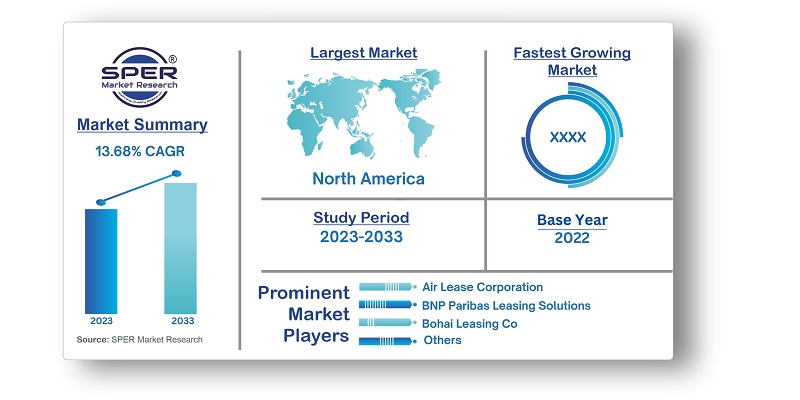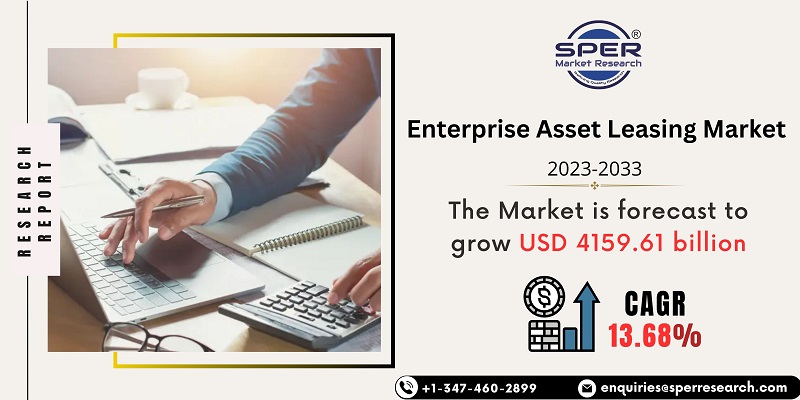
Enterprise Asset Leasing Market Growth, Size, Trends, Share, Revenue, Scope, Challenges and Future Outlook
Enterprise Asset Leasing Market Size- By Asset Type, By Leasing Type, By Organization Size, By Industry Vertical- Regional Outlook, Competitive Strategies and Segment Forecast to 2033
| Published: Jul-2023 | Report ID: BFSI2326 | Pages: 1 - 244 | Formats*: |
| Category : BFSI | |||
- Budget and Cash Flow Optimization: Enterprise asset leasing allows firms to optimize expenses and successfully manage cash flow. Leasing enables organizations to obtain needed assets without paying big upfront fees, allowing capital to be used for other strategic investments and operational needs.
- Consumer Preferences Shifting: Customer preferences are changing, and the rise of the subscription-based economy is increasing demand for leasing services. Customers are increasingly choosing asset access over ownership because it provides flexibility, affordability, and the capacity to update as needed.


| Report Metric | Details |
| Market size available for years | 2019-2033 |
| Base year considered | 2022 |
| Forecast period | 2023-2033 |
| Segments covered | By Asset Type, By Leasing Type, By Organization Size, By Industry Vertical |
| Regions covered | Asia-Pacific, Europe, Middle East and Africa, North America, Latin America |
| Companies Covered | Air Lease Corporation, BNP Paribas Leasing Solutions, Bohai Leasing Co. Ltd, Enterprise Asset Leasing, General Electric Company, ICBC Financial Leasing Co. Ltd, Origa Leasing, ORIX Corporation, Sumitomo Mitsui Finance and Leasing Co., Ltd, Wells Fargo Bank N.A |
- Business and Corporations
- Financial Institutions and Investors
- Industry-specific Businesses
- Professionals and Consultants
| By Asset Type: |
|
| By Leasing Type: |
|
| By Organization Size: |
|
| By Industry Vertical: |
|
- Global Enterprise Asset Leasing Market Size (FY’2023-FY’2033)
- Overview of Global Enterprise Asset Leasing Market
- Segmentation of Global Enterprise Asset Leasing Market By Asset Type (Commercial Vehicles, Real Estate, Machinery and Industrial Equipment, Others)
- Segmentation of Global Enterprise Asset Leasing Market By Leasing Type (Operating Lease, Financial Lease)
- Segmentation of Global Enterprise Asset Leasing Market By Organization Size (SMEs, Large Enterprises)
- Segmentation of Global Enterprise Asset Leasing Market By Industry Vertical (Construction, Government and Public Sector, Manufacturing, Transportation and Logistics, Others)
- Statistical Snap of Global Enterprise Asset Leasing Market
- Expansion Analysis of Global Enterprise Asset Leasing Market
- Problems and Obstacles in Global Enterprise Asset Leasing Market
- Competitive Landscape in the Global Enterprise Asset Leasing Market
- Effects of COVID-19 and demonetization on Global Enterprise Asset Leasing Market
- Details on Current Investment in Global Enterprise Asset Leasing Market
- Competitive Landscape of Global Enterprise Asset Leasing Market
- Prominent Players in the Global Enterprise Asset Leasing Market
- SWOT Analysis of Global Enterprise Asset Leasing Market
- Global Enterprise Asset Leasing Market Future Outlook and Projections (FY’2023-FY’2033)
- Recommendations from Analyst
1.1. Scope of the report1.2. Market segment analysis
2.1. Research data source2.1.1. Secondary Data2.1.2. Primary Data2.1.3. SPER’s internal database2.1.4. Premium insight from KOL’s2.2. Market size estimation2.2.1. Top-down and Bottom-up approach2.3. Data triangulation
4.1. Driver, Restraint, Opportunity and Challenges analysis4.1.1. Drivers4.1.2. Restraints4.1.3. Opportunities4.1.4. Challenges4.2. COVID-19 Impacts of the Global Enterprise Asset Leasing Market
5.1. SWOT Analysis5.1.1. Strengths5.1.2. Weaknesses5.1.3. Opportunities5.1.4. Threats5.2. PESTEL Analysis5.2.1. Political Landscape5.2.2. Economic Landscape5.2.3. Social Landscape5.2.4. Technological Landscape5.2.5. Environmental Landscape5.2.6. Legal Landscape5.3. PORTER’s Five Forces5.3.1. Bargaining power of suppliers5.3.2. Bargaining power of buyers5.3.3. Threat of Substitute5.3.4. Threat of new entrant5.3.5. Competitive rivalry5.4. Heat Map Analysis
6.1. Global Enterprise Asset Leasing Market Manufacturing Base Distribution, Sales Area, Product Type6.2. Mergers & Acquisitions, Partnerships, Product Launch, and Collaboration in Global Enterprise Asset Leasing Market
7.1. Global Enterprise Asset Leasing Market Value Share and Forecast, By Asset Type, 2023-20337.2. Commercial Vehicles7.3. Real Estate7.4. Machinery and Industrial Equipment7.5. Others
8.1. Global Enterprise Asset Leasing Market Value Share and Forecast, By Leasing Type, 2023-20338.2. Operating Lease8.3. Financial Lease
9.1. Global Enterprise Asset Leasing Market Value Share and Forecast, By Organization Size, 2023-20339.2. SMEs9.3. Large Enterprises
10.1. Global Enterprise Asset Leasing Market Value Share and Forecast, By Industry Vertical, 2023-203310.2. Construction10.3. Government and Public Sector10.4. Manufacturing10.5. Transportation and Logistics10.6. Others
11.1. Global Enterprise Asset Leasing Market Size and Market Share
12.1. Global Enterprise Asset Leasing Market Size and Market Share By Asset Type (2019-2026)12.2. Global Enterprise Asset Leasing Market Size and Market Share By Asset Type (2027-2033)
13.1. Global Enterprise Asset Leasing Market Size and Market Share By Leasing Type (2019-2026)13.2. Global Enterprise Asset Leasing Market Size and Market Share By Leasing Type (2027-2033)
14.1. Global Enterprise Asset Leasing Market Size and Market Share By Organization Size (2019-2026)14.2. Global Enterprise Asset Leasing Market Size and Market Share By Organization Size (2027-2033)
15.1. Global Enterprise Asset Leasing Market Size and Market Share By Industry Vertical (2019-2026)15.2. Global Enterprise Asset Leasing Market Size and Market Share By Industry Vertical (2027-2033)
16.1. Global Enterprise Asset Leasing Market Size and Market Share By Region (2019-2026)16.2. Global Enterprise Asset Leasing Market Size and Market Share By Region (2027-2033)16.3. Asia-Pacific16.3.1. Australia16.3.2. China16.3.3. India16.3.4. Japan16.3.5. South Korea16.3.6. Rest of Asia-Pacific16.4. Europe16.4.1. France16.4.2. Germany16.4.3. Italy16.4.4. Spain16.4.5. United Kingdom16.4.6. Rest of Europe16.5. Middle East and Africa16.5.1. Kingdom of Saudi Arabia16.5.2. United Arab Emirates16.5.3. Rest of Middle East & Africa16.6. North America16.6.1. Canada16.6.2. Mexico16.6.3. United States16.7. Latin America16.7.1. Argentina16.7.2. Brazil16.7.3. Rest of Latin America
17.1. Air Lease Corporation17.1.1. Company details17.1.2. Financial outlook17.1.3. Product summary17.1.4. Recent developments17.2. BNP Paribas Leasing Solutions17.2.1. Company details17.2.2. Financial outlook17.2.3. Product summary17.2.4. Recent developments17.3. Bohai Leasing Co. Ltd.17.3.1. Company details17.3.2. Financial outlook17.3.3. Product summary17.3.4. Recent developments17.4. Enterprise Asset Leasing17.4.1. Company details17.4.2. Financial outlook17.4.3. Product summary17.4.4. Recent developments17.5. General Electric Company17.5.1. Company details17.5.2. Financial outlook17.5.3. Product summary17.5.4. Recent developments17.6. ICBC Financial Leasing Co. Ltd17.6.1. Company details17.6.2. Financial outlook17.6.3. Product summary17.6.4. Recent developments17.7. Origa Leasing17.7.1. Company details17.7.2. Financial outlook17.7.3. Product summary17.7.4. Recent development17.8. ORIX Corporation17.8.1. Company details17.8.2. Financial outlook17.8.3. Product summary17.8.4. Recent development17.9. Sumitomo Mitsui Finance and Leasing Co., Ltd.17.9.1. Company details17.9.2. Financial outlook17.9.3. Product summary17.9.4. Recent development17.10. Wells Fargo Bank N.A.17.10.1. Company details17.10.2. Financial outlook17.10.3. Product summary17.10.4. Recent development17.11. Others
SPER Market Research’s methodology uses great emphasis on primary research to ensure that the market intelligence insights are up to date, reliable and accurate. Primary interviews are done with players involved in each phase of a supply chain to analyze the market forecasting. The secondary research method is used to help you fully understand how the future markets and the spending patterns look likes.
The report is based on in-depth qualitative and quantitative analysis of the Product Market. The quantitative analysis involves the application of various projection and sampling techniques. The qualitative analysis involves primary interviews, surveys, and vendor briefings. The data gathered as a result of these processes are validated through experts opinion. Our research methodology entails an ideal mixture of primary and secondary initiatives.



Frequently Asked Questions About This Report
PLACE AN ORDER
Year End Discount
Sample Report
Pre-Purchase Inquiry
NEED CUSTOMIZATION?
Request CustomizationCALL OR EMAIL US
100% Secure Payment






Related Reports
Our Global Clients
Our data-driven insights have influenced the strategy of 200+ reputed companies across the globe.






















